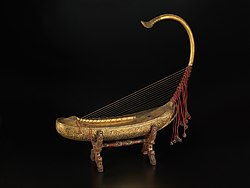
Back Saung gauk German Saung Finnish Saung French Szaung gauk Hungarian Saung ID サウン・ガウ Japanese စောင်းကောက် Burmese Saung Dutch Saung Polish Саунг Russian
 Saùng-Gauk, 19th century | |
| String instrument | |
|---|---|
| Classification | String instrument (plucked) |
| Hornbostel–Sachs classification | 322
|
| Related instruments | |
| |
The saung (Burmese: စောင်း, MLCTS caung; also known as the saung-gauk (စောင်းကောက်): IPA: [sáʊɰ̃ɡaʊʔ], Burmese harp, Burma harp, or Myanmar harp), is an arched harp used in traditional Burmese music. The saung is regarded as a national musical instrument of Burma.[3] The saung is unique in that it is a very ancient harp tradition and is said to be the only surviving harp in Asia.[4][5]
- ^ Sadie Stanley, ed. (1984). "T'na". The New Grove Dictionary of Musical Instruments. Vol. 3. Macmillan. p. 601
- ^ Sadie Stanley, ed. (1984). "Na den". The New Grove Dictionary of Musical Instruments. Vol. 2. Macmillan. p. 736
- ^ "Myanmar - Burmese harp (saung-gauk)". Royal Collection Trust. Retrieved 8 March 2023.
- ^ Miller, Terry E. and Sean Williams. The Garland handbook of Southeast Asian music. Routledge, 2008. ISBN 0-415-96075-4
- ^ However the site Harp History site mentions that a similar instrument, called (according to the site) the pin nam tao, whose picture is shown on the site, is played in Thailand today, the main difference being (according to the site) that the Burmese arched harp has 13 strings while the Thai arched harp has 15 strings. (In fact the picture purported to be that of the Burmese arched harp on the site shows an instrument with 16 strings and that of the purported Thai arched harp an instrument with 14 strings )
© MMXXIII Rich X Search. We shall prevail. All rights reserved. Rich X Search